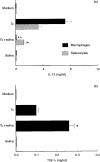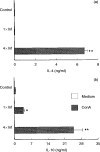Successive tick infestations selectively promote a T-helper 2 cytokine profile in mice
- PMID: 10233725
- PMCID: PMC2326753
- DOI: 10.1046/j.1365-2567.1999.00683.x
Successive tick infestations selectively promote a T-helper 2 cytokine profile in mice
Abstract
Several studies have revealed that T lymphocytes and cytokines play a crucial role in determining the outcome of parasitic infections in terms of protective immunity. In this study we found that Rhipicephalus sanguineus tick saliva stimulates transforming growth factor-beta (TGF-beta), and reduces interleukin-12 (IL-12) secretion by cells from normal C3H/HeJ mice. Moreover, murine lymph node cells harvested 6 days after the fourth infestation with ticks presented an 82.4% decrease in their proliferative response to concanavalin A (Con A) compared with the response of control cells. In addition, lymph node cells cultured in the presence of Con A showed a T-helper 2-type (Th2-type) cytokine profile, represented by augmented IL-4 and IL-10 and TGF-beta. On the other hand, the IL-2, interferon-gamma (IFN-gamma) and IL-12 synthesis was significantly inhibited. These results indicate that ticks may modulate the host's immune response through saliva injection. Considering that C3H/HeJ mice develop no protective immunity to R. sanguineus infestation, our results suggest that tick-induced Th2-type cytokines and a decreased proliferative response probably lead the host to a susceptible state to both tick and tick-transmitted pathogens.
Figures






References
-
- Cupp EW. Biology of ticks. Vet Clin North Am Small Anim Prac. 1991;21:1. - PubMed
-
- Goddard J. Focus of human parasitism by the brown dog tick, Rhipicephalus sanguineus(Acari: Ixodidae) J Med Entomol. 1989;26:628. - PubMed
-
- Wikel SK. Host immunity to ticks. Annu Rev Entomol. 1996;41:1. - PubMed
-
- Garin NS, Grabarev PA. Protective reactions in rabbits and guinea-pigs upon repeated feeding on them of ixodid ticks Rhipicephalus sanguineus (Latr, 1806) Meditsinskaia Parazitologiia I Parazitarnye Bolezni. 1972;41:274. - PubMed
Publication types
MeSH terms
Substances
LinkOut - more resources
Full Text Sources

